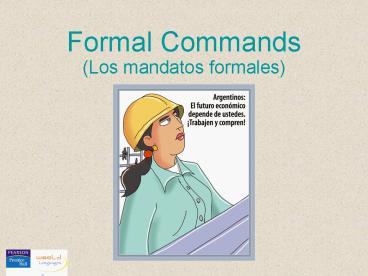Formal commands - PowerPoint PPT Presentation
1 / 10
Title:
Formal commands
Description:
Title: Formal commands Author: WR Cisco Last modified by: kgould Created Date: 10/5/1999 4:32:08 PM Document presentation format: On-screen Show (4:3) – PowerPoint PPT presentation
Number of Views:200
Avg rating:3.0/5.0
Title: Formal commands
1
Formal Commands
(Los mandatos formales)
2
Formal Commands
We use commands to give instructions or to ask
people to do things. In Spanish, commands have
different forms to distinguish between formal
(usted/ustedes) and informal (tú/vosotros)
address. Formal commands use subjunctive forms,
with the implied meaning that the speaker is
trying to influence the listener to do something.
3
Formal Commands
We might make a simple statement to communicate a
fact. Juan speaks French well, so we tell him so.
Juan, Ud. habla bien el francés.
Its very nice that Juan speaks French, but we
are in Madrid! So we tell him . . .
Por favor, Juan, hable Ud. español.
Commands are used (both politely and otherwise)
to persuade others to do our bidding. We are
trying to get Juan to do something that we want
him to do.
4
Formal Commands
As mentioned, formal commands are based on
subjunctive forms. Notice the following chart
Infinitive
Subjunctive
Formal commands
Ud.
Uds.
hablar
hable
hable
hablen
pensar
piense
piense
piensen
comer
coma
coma
coman
saber
sepa
sepa
sepan
escribir
escriba
escriba
escriban
ir
vaya
vaya
vayan
pedir
pida
pida
pidan
5
Formal Commands
Of course, the same six (DISHES) verbs are
irregular with command forms as they are in the
subjunctive.
dé, den
Dar ? Ir ? Ser ? Haber ? Estar ? Saber ?
vaya, vayan
sea, sean
haya, hayan
esté, estén
sepa, sepan
6
Formal Commands
Following are examples of formal commands
Hable con su agente de viajes.
Speak to your travel agent.
Despida a ese empleado, Sr. Ruiz.
Fire that employee, Mr. Ruiz.
Salgan pronto de la oficina.
Leave the office soon.
Piensen antes de hablar.
Think before speaking.
7
Formal Commands
Negative commands are formed by placing no in
front of the command form.
No llegue tarde.
Dont arrive late.
No dén propinas a todos los empleados.
Dont give tips to all of the employees.
8
Formal Commands
Subject pronouns may be used with commands for
emphasis or clarification. As a rule, they are
placed after the verb.
Piense usted.
You think.
No se preocupen
Dont you worry.
9
Formal Commands
Object pronouns follow and are attached to
affirmative commands and precede negative
commands.
Affirmative commands with pronouns attached
require a written accent.
Váyase de aquí!
Leave here!
Tráiganmelo, por favor.
Bring it to me, please.
No se levante, señorita.
Dont get up, miss.
No se lo muestre al jefe.
Dont show it to the boss.
10
FIN































